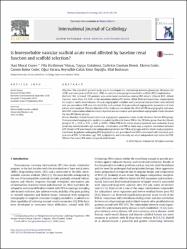Is bioresorbable vascular scaffold acute recoil affected by baseline renal function and scaffold selection?

Göster/
Erişim
info:eu-repo/semantics/openAccessTarih
2016Yazar
Güneş, Hacı MuratKızılırmak Yılmaz, Filiz
Gökdeniz, Tayyar
Demir, Gültekin Günhan
Güler, Ekrem
Babür Güler, Gamze
Karaca, Oğuz
Çakal, Beytullah
İbişoğlu, Ersin
Boztosun, Bilal
Üst veri
Tüm öğe kaydını gösterKünye
Güneş, H. M., Kızılırmak Yılmaz, F., Gökdeniz, T., Demir, G. G., Güler, E., Babür Güler, G. ... Boztosun, B. (2016). Is bioresorbable vascular scaffold acute recoil affected by baseline renal function and scaffold selection? International Journal Of Cardiology, 224, 388-393. https://dx.doi.org/10.1016/j.ijcard.2016.09.024Özet
Objective: The aim of the present study was to investigate the relationship between glomerular filtration rate (GFR) and acute post-scaffold recoil (PSR) in patients undergoing bioresorbable scaffold (BVS) implantation. Methods: We included 130 patients who underwent everolimus-eluting BVS device (Absorb BVS; Abbott Vascular, Santa Clara, CA, USA) or the novolimus-eluting BVS device (Elixir Medical Corporation) implantations for single or multi-vessel disease. Clinical, angiographic variables and procedural characteristics were defined and pre-procedural GFR was calculated for each patient. Post-procedural angiographic parameters of each patient were analyzed. Primary objective of the study was to evaluate the effect of GFR on angiographic outcomes after BVS implantation while secondary objective was to compare post-procedural angiographic results between the two BVS device groups. Results: Baseline clinical characteristics and angiographic parameters were similar between the two BVS groups. Post-procedural angiographic analysis revealed significantly lower PSR in the DESolve group than the Absorb group (0.10 +/- 0.04 vs. 0.13 +/- 0.05, p: 0.003). When PSR in the whole study population was evaluated, it was positively correlated with age, tortuosity, calcification and PBR as there was a negative correlation between GFR. Besides GFR were found to be independent predictors for PSR in all groups and the whole study population. Conclusion: In patients undergoing BVS implantation, pre-procedural low GFR is associated with increased post-procedural PSR. Calcification, age, PBR, dyslipidemia and tortuosity are other independent risk factors for PSR. DESolve has lower PSR when compared with Absorb.
WoS Q Kategorisi
Q2Scopus Q Kategorisi
Q1Kaynak
International Journal Of CardiologyCilt
224Koleksiyonlar
- Makale Koleksiyonu [3777]
- PubMed İndeksli Yayınlar Koleksiyonu [4230]
- Scopus İndeksli Yayınlar Koleksiyonu [6574]
- WoS İndeksli Yayınlar Koleksiyonu [6631]

















